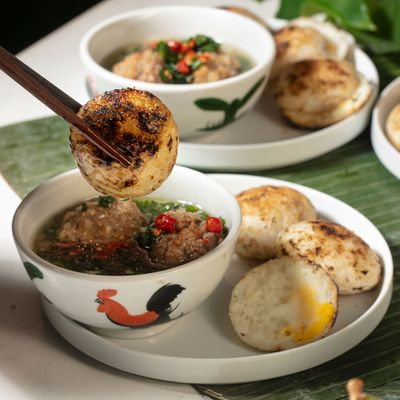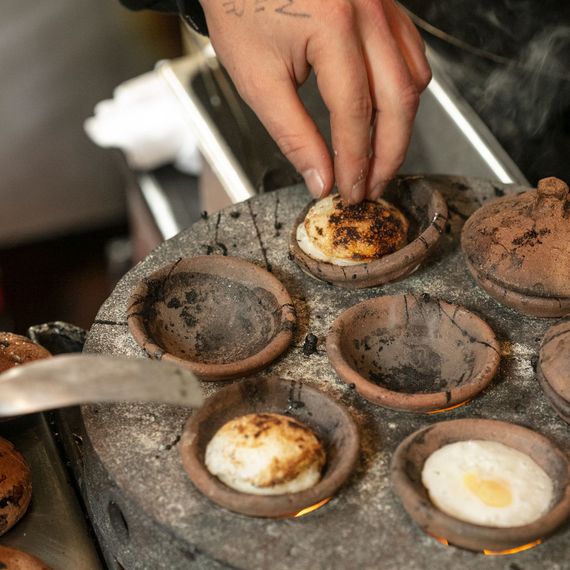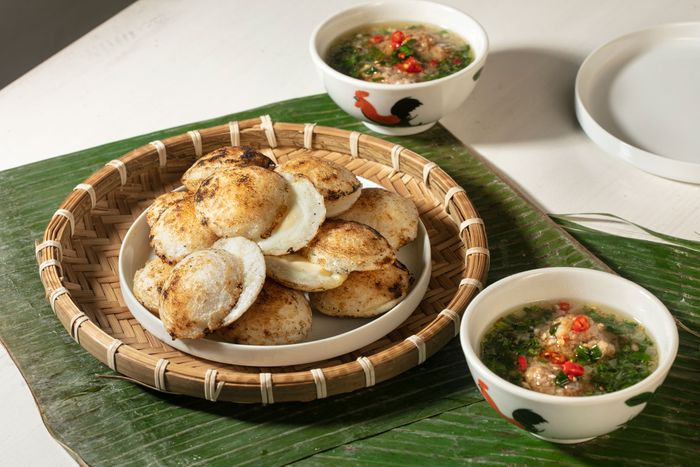
The crew behind Di An Di have been working overtime to get the details right for their lunch menu. They imported clay ramekins from Ninh Thuan, a province in Vietnam that’s known for its pottery, and got someone to fabricate a pot just to make a highly specific type of rice roll; and they sought out river crabs (which are ultimately too hard to consistently source) for the bun rieu, a noodle soup that, as a result, didn’t make the final menu. Launching this Saturday, after several test rounds, the daytime menu is almost entirely different from what the restaurant serves at night — or, really, what anyone else is in New York is doing. In fact, the mix of dishes is not just new to the restaurant — many of them are rarely seen in New York at all.
If there’s an overall theme to the menu, which is the work of Di An Di’s chef Dennis Ngo and chef de cuisine Jerald Head, it’s “rice.” All but one of the dishes incorporates it. You’ll get your eggs with the banh bot chien, an omelette with fat, square daikon rice cakes, topped with pork floss, and served with a powerfully sweet soy sauce. There’s a vegan version of bun rieu (a soup that’s traditionally made with tomato and freshwater crab). And diners will find two sticky-rice dishes including xoi la cam with magenta leaf, toasted peanut, sesame, and coconut. The most intriguing dish, however, is the banh can, which Ngo and Head are calling a “rice muffin.” It’s a rare dish that drives home what makes the new lunch menu here so exciting.


So, what are they? To start, the banh can are cooked in small ceramic ramekins made from red dirt. (Here they’re cooked over a stove top. In the cities of Da Lat and Nha Trang, where they’re from, it’d be charcoal.) Into the ramekins goes a rice batter that the Di An Di kitchen makes with mix of rices that’s first shot through the blender. It’s crucial that they get the right amount: “If we add too much batter we don’t have the good contrast from crisp to chewy,” Head explains. A quail egg is then cracked to order over the batter, and cooked until it’s soft and jammy.
Once the eggs are cooked, half the banh can are flipped over on top of the others. They’re crispy on the outside, spotted with char marks and unevenly golden, but chewy inside and bubbly on top. Each order comes with nuoc mam, a dipping sauce made of fish sauce cut with chicken broth, and a strong dose of scallion oil and red chilis.



Resting within that sauce are two xiu mai, or pork meatballs, taking a swim. They’re tender and well-seasoned, with shallot, garlic, fish sauce, pork fat, and a compound of equal parts sugar, salt, and MSG. (There’s a vegetarian option, too, with a vegan mushroom taro meatball and a vegan version of nuoc mam.)
The smoky, crispiness of the banh can soaked in the nuoc mam, a one-two punch of savoriness, immediately charms your palate. It’s a sort of dish you could find yourself thinking about days later, hatching plans to go eat again. It’s also just one of several reasons to head to Di An Di for lunch. Not all are served on plates. Along with daytime-appropriate cocktails like a Viet-chelda, they’re collaborating with Nguyen Coffee Supply on a coffee menu that’s, unsurprisingly, not your usual cortados and cold brews. There’s coconut coffee, Hanoi’s luscious egg coffee, and an ube coffee like the one that NCS’s Sahra Nguyen made at her on hiatus Cafe Phin pop-up.






